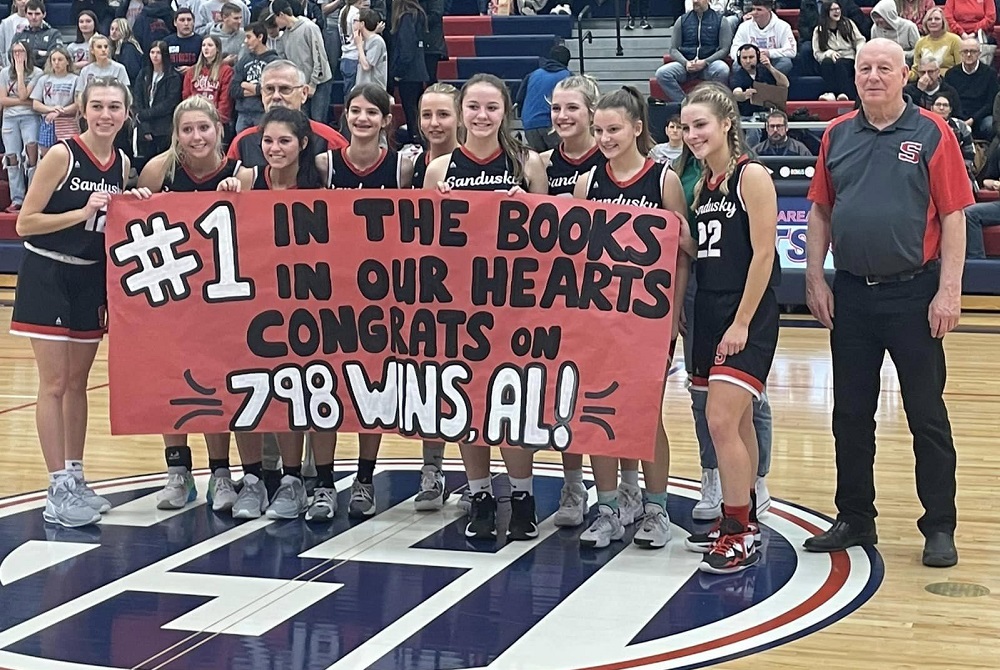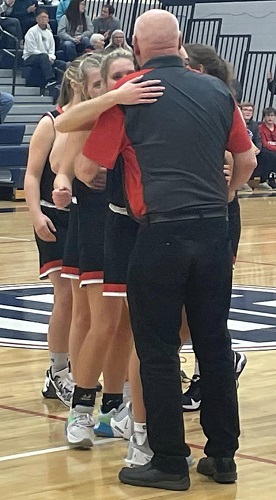
Regulation with Roots
December 3, 2015
By Jack Roberts
MHSAA Executive Director
The following is an excerpt from “History, Rationale and Application of the Essential Regulations of High School Athletics in Michigan.”
Throughout the years, schools of this and every other state have identified problems relating to school transfers.
There is recruitment of athletes and undue influence. There is school shopping by families for athletic reasons. There is jumping by students from one school to another for athletic reasons because they couldn't get along with a coach or saw a greater opportunity to play at another school or to win a championship there. There is the bumping of students off a team or out of a starting lineup by incoming transfers, which often outrages local residents. There is the concentration of talent on one team by athletic-motivated transfers. There is friction between schools as one becomes the traditional choice for students who specialize in a particular sport. There is imbalance in competition as a result. And there is always the concern that the athletic-motivated transfer simply puts athletics above academics, which is inappropriate in educational athletics.
All states have developed rules to address the problems related to school transfers. In some states it is called a transfer rule and in other states a residency rule, because linking school attendance to residence is one of the most effective tools for controlling eligibility of transfers. None of the state high school association rules is identical, but all have the intention of preventing recruiting, school shopping and jumping, student bumping, friction, imbalance and overemphasis, as well as the intention of promoting fairness in athletic competition and the perspective that students must go to school first for an education and only secondarily to participate in interscholastic athletics.
The transfer/residency rule is a legally and historically tested but still imperfect tool to control athletic-motivated transfers and other abuses. It is a net which catches some students it should not, and misses some students that should not be eligible. This is why all state high school associations have procedures to review individual cases and grant exceptions; and why all state high school associations have procedures to investigate allegations and to penalize violations where they are confirmed.
Over the years, state high school associations have considered four options to handle transfers. The first two options are the easiest courses: either (1) let schools decide themselves about transfers, as Michigan once did, but this leads to inconsistent applications and few states now subscribe to such an approach; or (2) make no exceptions at all, rendering all transfer students ineligible for a period of time, but this becomes patently unfair for some students and no state high school association subscribes to that extreme, although it would be easy to administer.
The third option – the ideal approach perhaps – would be to investigate the motivation of every transfer and allow quicker eligibility or subvarsity eligibility to those which are not motivated by athletics, but this is very time consuming if not impossible to administer. No state high school association has sufficient staff and money to consider every detail of every transfer.
This is why a fourth option has been most popular with most state high school associations. This is a middle ground which stipulates a basic rule, some exceptions (15 exceptions in Michigan), and procedures to consider and grant waivers (a primary role of the MHSAA Executive Committee).
It is certain that the MHSAA transfer rule is imperfect. However, whatever few imperfections exist are remedied through a process by which member school administrators may make application to the MHSAA Executive Committee to waive the rule if, in the committee's opinion, the rule fails to serve any purpose for which it is intended or in its application creates an undue hardship on the student. In a typical year, the Executive Committee will receive approximately 250 requests to waive the transfer regulation, approving approximately 60 percent of those requests.
The committee brings to its considerations the following rationale, most recently reviewed and reaffirmed on Aug. 5, 2015:
- The rule tends to insure equality of competition in that each school plays students who have been in that school and established their eligibility in that school.
- The rule tends to prevent students from “jumping” from one school to another.
- The rule prevents the “bumping” of students who have previously gained eligibility in a school system by persons coming from outside the school system.
- The rule tends to prevent interscholastic athletic recruiting.
- The rule tends to prevent or discourage dominance of one sport at one school with a successful program, i.e., the concentration of excellent baseball players at one school to the detriment of surrounding schools through transfers and to the detriment of the natural school population and ability mix.
- The rule tends to create and maintain stability in that age group, i.e., it promotes team stability and team work expectation fulfillment.
- The rule is designed to discourage parents from “school-shopping” for athletic purposes.
- The rule is consistent with educational philosophy of going to school for academics first and athletics second.
- It eliminates family financial status from becoming a factor on eligibility, thus making a uniform rule for all students across the state of Michigan (i.e., tuition and millage considerations).
- It tends to encourage competition between nonpublic and public schools, rather than discourage that competition.
- It tends to reduce friction or threat of students changing schools because of problems they may have created or because of their misconduct, etc.
Following the adoption of a more standardized statewide transfer rule in 1982, there were multiple legal challenges. However, in 1986, the Michigan Court of Appeals determined that a rational basis exists for the transfer regulation and that the rule, with its exceptions, is not overbroad and is neither arbitrary nor capricious, noting that neither a fundamental right nor suspect classification is involved. Berschback v. Grosse Pointe Schools 154 Mich App 102 (1986). That decision is also noteworthy for this statement which has halted or decided subsequent legal challenges: “This Court is not the proper forum for making or reviewing decisions concerning the eligibility of transferring students in interscholastic athletics.”
There were two major changes in the MHSAA transfer regulation during the 1980s. The first, the athletic-motivated transfer rule, led to the busiest period of litigation in the MHSAA’s history. The other major change, arguably of equal impact, was implemented without any controversy.
This second subtle but substantial change occurred in 1987 when language was adopted to limit eligibility after a transfer to the non-public school closest to the student’s residence, as opposed to any non-public school in whose service area the student lived. “Service area” did not have a consistent definition and created unnecessary concern that non-public schools had the advantage of huge, undefined attendance areas, compared to public school districts at that time.
Some high school associations prescribe geographic boundaries or mileage limitations for students transferring to non-public schools. Michigan simply says it’s only the non-public school closest to the student’s residence, where eligibility may be immediate.
PHOTO: The MHSAA Transfer Regulation dates back to the early 1980s when the Association building stood on Trowbridge Road in East Lansing.

DeMott's Long-Revered Legacy Grows to Include All-Time Wins Record
By
Paul Costanzo
Special for MHSAA.com
January 11, 2023
This past Friday night felt like a home game for Al DeMott.
 Family, friends and former players were packed into the stands to watch him set the MHSAA record for career wins by a girls basketball coach.
Family, friends and former players were packed into the stands to watch him set the MHSAA record for career wins by a girls basketball coach.
There was a postgame celebration on the court, and a congratulatory message displayed on the video board.
Of course, DeMott and the Wolves hadn’t just won a game in their home gym – they had done it at Unionville-Sebewaing.
But anywhere in the Thumb can feel like home.
“USA, they really did a lot,” DeMott said. “They put a thing up on the board, their coach came out after the game and said all kinds of nice things. USA was a very generous host. They went above and beyond.
“That’s the way it is in Thumb basketball; we all look after each other and support each other. In all sports, really. When one team goes on a run, the whole Thumb gets on the bandwagon.”
Sandusky’s win was the 798th of DeMott’s career, putting him ahead of retired Detroit Country Day coach Frank Orlando on the all-time list.
It’s a record more than 40 years in the making, as DeMott took over the program in 1979. In that time, Sandusky has won 23 league titles, 27 District titles, seven Regional titles and earned an MHSAA Finals runner-up finish (1999). The program hasn’t had a losing season since 1982.
“I’ve been doing it a long time,” DeMott said. “Our program has had a lot of success. We’ve had a pretty good run going for a lot of years. The numbers don’t really mean that much to me. It’s nice for our program that it’s been successful as it has. That it’s been steady for a long time. There are a lot of good people that have done a good job.”
DeMott’s career record stands at 799-206, as the Wolves won another game Tuesday night to push their season record to 9-2.
Before he’s done, the record will no doubt be well above 800. How far above depends on how long DeMott sticks around. Right now, there’s no immediate plan to stop.
 “Every year, when you get done with the year and your season ends, you’re tired,” DeMott said. “But I’m still having a lot of fun doing it. Another thing, God’s blessed me with good health. I’ve been fortunate to keep going strong with this. I’ve been working on trying to get someone to take it over – I’ve got a granddaughter in eighth grade, and I would like to sit and watch her.”
“Every year, when you get done with the year and your season ends, you’re tired,” DeMott said. “But I’m still having a lot of fun doing it. Another thing, God’s blessed me with good health. I’ve been fortunate to keep going strong with this. I’ve been working on trying to get someone to take it over – I’ve got a granddaughter in eighth grade, and I would like to sit and watch her.”
One thing that keeps DeMott going is the support he gets from those around him in the program.
He’s had the opportunity to coach with his three daughters, Desiree, Allison and Marissa, who also played for him. His longtime assistant coach and childhood friend, Ray Lee, has been on the staff since 1982. DeMott said that during his time at Sandusky, he’s had only six or seven JV coaches.
“I have such a good support system,” DeMott said. “I have loyal assistant coaches.”
The community, both in Sandusky and throughout the Thumb, also has shown DeMott tremendous support, even as he was struggling to get the program off the ground in the early years.
“With the start I had here, if somebody got off to the start I did, they’d be gone, probably,” DeMott said. “It’s been phenomenal. I can’t believe all the texts and emails and calls I’ve got. People have gone above and beyond. There’s been a lot of support. We’ve always got really good support.”
And, of course, nothing can beat the support that DeMott gets at home, as his wife Tammy has been there since the beginning.
“My wife has been a saint,” DeMott said. “When I first started doing this coaching, she was a little iffy about it. When I first started, I was working at the bank and I only had two weeks vacation. We used to use one of the weeks of vacation to go to team camp. She stays up and does stats with me. She’s my biggest supporter I’ve ever had.”
All that support has allowed DeMott to build a consistent winner at a public school with an enrollment just over 300 students.
He started a youth program fairly early in his time at Sandusky, and it’s still going strong. He said there were 40 third and fourth graders in the gym this past Saturday starting their latest season.
As kids grow up in the program, they dream of one day playing for the varsity team and DeMott.
 “This achievement couldn’t have been accomplished by a more humble and deserving person,” said Haley Nelson, a 2018 Sandusky grad who played for DeMott before playing at Saginaw Valley State. “In Sandusky, playing under Coach DeMott is something you look forward to as soon as you start playing basketball in elementary school. He’s built a standard as to what Sandusky girls basketball is, and it made you want to work hard to live up to it. The program he’s built is a testament to his hard work and dedication year-round. I think it would be tough to find another high school coach as committed to their program as Al is. He sees each of his players as people far beyond what they can contribute on the court, and for that reason, the impact he has on his players extends far beyond basketball.”
“This achievement couldn’t have been accomplished by a more humble and deserving person,” said Haley Nelson, a 2018 Sandusky grad who played for DeMott before playing at Saginaw Valley State. “In Sandusky, playing under Coach DeMott is something you look forward to as soon as you start playing basketball in elementary school. He’s built a standard as to what Sandusky girls basketball is, and it made you want to work hard to live up to it. The program he’s built is a testament to his hard work and dedication year-round. I think it would be tough to find another high school coach as committed to their program as Al is. He sees each of his players as people far beyond what they can contribute on the court, and for that reason, the impact he has on his players extends far beyond basketball.”
Nelson is one of many Sandusky players who have gone onto play at the next level. Many have stayed connected to the sport through coaching, as well. But in general, DeMott touts the academic success of his program, and the pride he has in the citizens his former players have grown to be.
“A lot of our former players, they’ve all done a lot of really good things,” DeMott said. “I couldn’t be prouder. There were quite a few there (at USA). It meant a lot to see them.”
One former player-turned-coach is Wayne State women’s basketball coach Carrie Lohr, who has set records of her own. She’s in her 12th season at Wayne State, and has won nearly 200 games. She became the program’s all-time winningest coach in 2019.
She counts DeMott as one of her biggest influences.
"Al is truly one of the best coaches in the state of Michigan," Lohr said. "I believe he could coach any team or sport to its highest potential. Al has an unwavering dedication and passion for the game of basketball and teaching young people. He is selfless, positive, consistent, knowledgeable and truly cares about the players he leads.
“Playing for Coach Al DeMott is still some of my best basketball memories ever. He has truly made a positive impact on my life as he has done for so many who have worn the Sandusky jersey. I wouldn't be where I am today without his mentorship. I am forever grateful to him and his support of me long after I left the court."
With the record behind him, DeMott now hopes the focus can return to this year’s team, which is 9-2 with its losses coming by a combined five points.
It’s clear he’s excited about this group, as the energy in his voice ratcheted up when asked about his players.
“I’ve got an awesome group to coach,” DeMott said. “They’re really good, smart, hard workers. They want to be successful, and they really like to play together. They love playing together. They’re a special group.”
 Paul Costanzo served as a sportswriter at The Port Huron Times Herald from 2006-15, including three years as lead sportswriter, and prior to that as sports editor at the Hillsdale Daily News from 2005-06. He can be reached at [email protected] with story ideas for Genesee, Lapeer, St. Clair, Sanilac, Huron, Tuscola, Saginaw, Bay, Arenac, Midland and Gladwin counties.
Paul Costanzo served as a sportswriter at The Port Huron Times Herald from 2006-15, including three years as lead sportswriter, and prior to that as sports editor at the Hillsdale Daily News from 2005-06. He can be reached at [email protected] with story ideas for Genesee, Lapeer, St. Clair, Sanilac, Huron, Tuscola, Saginaw, Bay, Arenac, Midland and Gladwin counties.
PHOTOS (Top) Sandusky girls basketball coach Al DeMott stands alongside his current team after they helped him break the MHSAA record for girls basketball victories Friday at Unionville-Sebewaing. (Middle) The USA scoreboard celebrated DeMott’s accomplishment. (Below) Players line up to congratulate DeMott on his milestone win. (Photos courtesy of Sandusky High School.)

